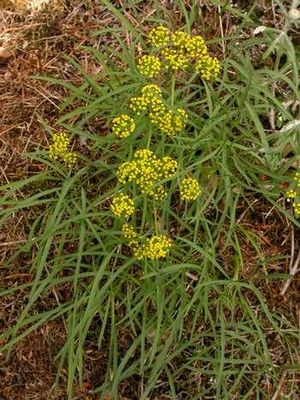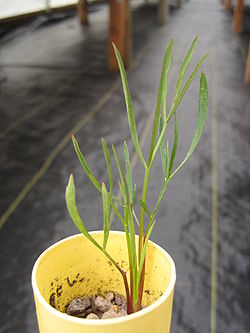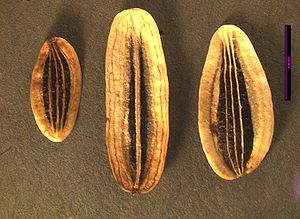Difference between revisions of "Lomatium triternatum"
m (Tag: VisualEditor) |
|||
| Line 1: | Line 1: | ||
| − | ''' | + | * Latin Name: ''Lomatium'' ''triternatum'' |
| + | * Family: Apiaceae | ||
| + | * Common Names: triternate biscuit-root | ||
| + | * Codon: LOMTRI | ||
[[File:LOTR BenLegler veg avg.jpg|thumb|300px|right|]] | [[File:LOTR BenLegler veg avg.jpg|thumb|300px|right|]] | ||
| − | + | ||
[[File:LOTR_BeccaReilly_sdl_good.JPG|thumb|250px|right|Lomatium triternatum]] | [[File:LOTR_BeccaReilly_sdl_good.JPG|thumb|250px|right|Lomatium triternatum]] | ||
===Taxonomy=== | ===Taxonomy=== | ||
| Line 28: | Line 31: | ||
===Distribution=== | ===Distribution=== | ||
| − | Throughout Washington and neighboring states, but more common east of the Cascades <ref name="Burke"> http://biology.burke.washington.edu/herbarium/imagecollection.php?Genus=Lomatium&Species=triternatum </ref> | + | Throughout Washington and neighboring states, but more common east of the Cascades <ref name="Burke">http://biology.burke.washington.edu/herbarium/imagecollection.php?Genus=Lomatium&Species=triternatum </ref> |
===Habitat=== | ===Habitat=== | ||
| − | Dry to somewhat moist open areas, low to mid-elevations. <ref name="Burke"> http://biology.burke.washington.edu/herbarium/imagecollection.php?Genus=Lomatium&Species=triternatum </ref> | + | Dry to somewhat moist open areas, low to mid-elevations. <ref name="Burke">http://biology.burke.washington.edu/herbarium/imagecollection.php?Genus=Lomatium&Species=triternatum </ref> |
===Uses=== | ===Uses=== | ||
| Line 50: | Line 53: | ||
abbie@wsu.edu | abbie@wsu.edu | ||
www.wsu.edu/pmc_nrcs/ | www.wsu.edu/pmc_nrcs/ | ||
| − | |||
</ref> | </ref> | ||
| Line 78: | Line 80: | ||
===References=== | ===References=== | ||
---- | ---- | ||
| − | < | + | <references /> |
Revision as of 16:00, 2 June 2020
- Latin Name: Lomatium triternatum
- Family: Apiaceae
- Common Names: triternate biscuit-root
- Codon: LOMTRI
Contents
Taxonomy
- Kingdom - Plantae – Plants
- Subkingdom - Tracheobionta – Vascular plants
- Superdivision - Spermatophyta – Seed plants
- Division - Magnoliophyta – Flowering plants
- Class - Magnoliopsida – Dicotyledons
- Subclass - Rosidae
- Order - Apiales
- Family - Apiaceae – Carrot family
- Genus - Lomatium Raf. – desertparsley
- Species - Lomatium triternatum (Pursh) J.M. Coult. & Rose – nineleaf biscuitroot
Plant Description
General: Perennial from an elongate and slightly thickened taproot, 2-8 dm. tall, the stems solitary or few, erect, covered with fine but stiff hairs.
Leaves: Leaves chiefly basal or low-cauline, but usually one or more reduced leaves on the middle or upper stem; leaves ternately or ternate-pinnately 2-3 times cleft into long, narrow or broader segments, 1-10 cm. long, highly variable in this feature.
Flowers: Inflorescence of compound umbels, the rays unequal, 2-10 cm. long at maturity; involucre none, involucel bractlets inconspicuous; calyx teeth none; flowers yellow.
Bloom Period
April to July [1]
Distribution
Throughout Washington and neighboring states, but more common east of the Cascades [1]
Habitat
Dry to somewhat moist open areas, low to mid-elevations. [1]
Uses
An infusion of the leaves and roots has been used in the treatment of chest complaints. An infusion of the flowers and upper leaves has been used in the treatment of colds and sore throats. [2]
Propagation
Germination began after 36 days of cold moist treatment. The majority germinated within the first 13 days, but continued sporadically for 67 days. True leaves appeared after 14 days. The seedlings were in the greenhouse for 77 days. Survival was about 53%. [3]
Seed
Seed sample from: 2011
Average Measurement: 9.5 x 3.3 x 1
Measurement Range: L: 7.25 - 12.5, W: 3 - 4, D: 0.5 - 1.5
Features
Shape: Seed a schizocarp, winged, laterally compressed, and ribbed.
Color: On one seed face, there are three white ribs that run across a dark reddish brown surface. On the opposite seed face there is one rib that bisects the dark brown.
Surface: Seeds are matte.
Latitudinal Cross Section: rhombic ![]()
Longitudinal Cross Section: elliptical ![]()
Basic Explanations and Assumptions:
The dimensions for the seeds are length x width x depth. The location of the hilum is used as the base of the seed, and the length is measured from hilum to the opposite apex. Where a style is present, the length is measured from the hilum to the bottom of the style. Width is measured at a right angle to the length at the widest part. Depth is measured at a right angle to the intersection of height and width lines.
Measurements included are the mean average for each measurement of ten separate seeds.
All measurements in millimeters unless otherwise noted.
References
- ↑ 1.0 1.1 1.2 http://biology.burke.washington.edu/herbarium/imagecollection.php?Genus=Lomatium&Species=triternatum
- ↑ http://www.naturalmedicinalherbs.net/herbs/l/lomatium-triternatum=nineleaf-biscuitroot.php
- ↑ Dave Skinner PMC Farm Manager USDA NRCS - Pullman Plant Materials Center Room 211A Hulbert Hall WSU Pullman, Washington 99164-6211 509-335-9689 509-335-2940 abbie@wsu.edu www.wsu.edu/pmc_nrcs/



